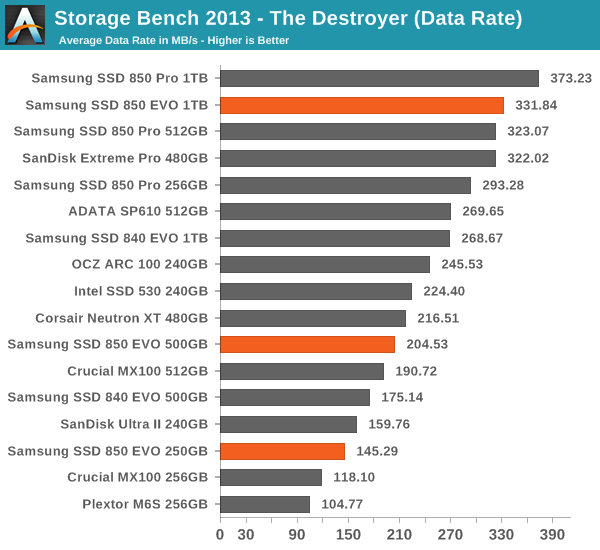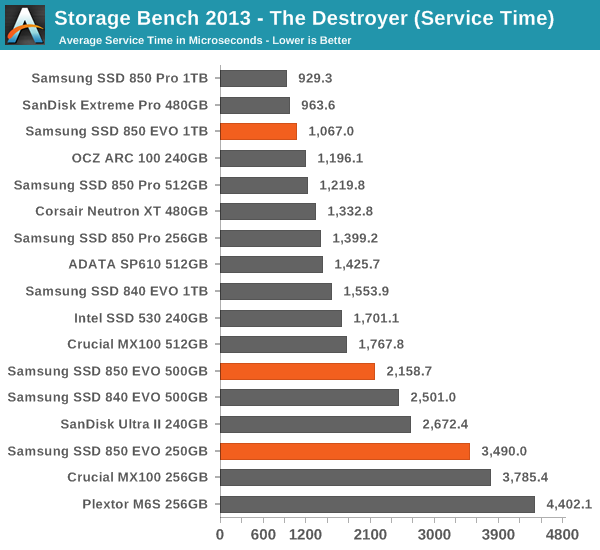Samsung SSD 850 EVO (120GB, 250GB, 500GB & 1TB) Review
by Kristian Vättö on December 8, 2014 10:00 AM ESTAnandTech Storage Bench 2013
Our Storage Bench 2013 focuses on worst-case multitasking and IO consistency. Similar to our earlier Storage Benches, the test is still application trace based – we record all IO requests made to a test system and play them back on the drive we are testing and run statistical analysis on the drive's responses. There are 49.8 million IO operations in total with 1583.0GB of reads and 875.6GB of writes. I'm not including the full description of the test for better readability, so make sure to read our Storage Bench 2013 introduction for the full details.
| AnandTech Storage Bench 2013 - The Destroyer | ||
| Workload | Description | Applications Used |
| Photo Sync/Editing | Import images, edit, export | Adobe Photoshop CS6, Adobe Lightroom 4, Dropbox |
| Gaming | Download/install games, play games | Steam, Deus Ex, Skyrim, Starcraft 2, BioShock Infinite |
| Virtualization | Run/manage VM, use general apps inside VM | VirtualBox |
| General Productivity | Browse the web, manage local email, copy files, encrypt/decrypt files, backup system, download content, virus/malware scan | Chrome, IE10, Outlook, Windows 8, AxCrypt, uTorrent, AdAware |
| Video Playback | Copy and watch movies | Windows 8 |
| Application Development | Compile projects, check out code, download code samples | Visual Studio 2012 |
We are reporting two primary metrics with the Destroyer: average data rate in MB/s and average service time in microseconds. The former gives you an idea of the throughput of the drive during the time that it was running the test workload. This can be a very good indication of overall performance. What average data rate doesn't do a good job of is taking into account response time of very bursty (read: high queue depth) IO. By reporting average service time we heavily weigh latency for queued IOs. You'll note that this is a metric we have been reporting in our enterprise benchmarks for a while now. With the client tests maturing, the time was right for a little convergence.

The faster NAND and better IO consistency results in increased performance in our 2013 Storage Bench. The 1TB version shines in the test and isn't far from the 850 Pro, but the 500GB and 250GB models end up being middle-class performers. Especially the performance of the 250GB model is a bit underwhelming because it is beaten by the Ultra II, even though the 850 EVO should have a performance advantage thanks to V-NAND.











97 Comments
View All Comments
Kevin G - Monday, December 8, 2014 - link
What version is the firmware of the 840 EVO? There is a notorious bug out there that'll drastically reduce the speed of the drive when it attempts to read data.See:
http://www.anandtech.com/show/8617/samsung-release...
romrunning - Monday, December 8, 2014 - link
That's the bug about reading really old data. If he did an upgrade, then it wouldn't be really old data on the new drive.It also doesn't apply to the point he was making - would I subjectively "feel" the difference if I upgrade to the 850 EVO from an older <insert_brand_here> SSD?
doggghouse - Monday, December 8, 2014 - link
On one of these review sites, they mentioned that the step up from HDD to SSD is enormous, but between the different generations of SSD the difference isn't nearly as noticeable. Depending on the test, the difference between HDD and SSD is anywhere from 2.5x faster (ex. sequential write) to 140x faster (ex. random write). You definitely will not see such a marked improvement going from one SSD to another.Also I agree with your point about the benchmarks being pointless for the average user. A lot of the benchmarks are geared towards enterprise usage. I think part of the problem is that the drives all behave pretty similarly (compared to HDD anyway), until they are pushed to the extremes. That's the only way for the reviews to differentiate between them, unless they find a particular weak point or flaw.
eanazag - Monday, December 8, 2014 - link
The performance profile of the drives and your workload will dictate if you notice the better performance. I would guess that you got a lot more GBs/$ when you picked up the Evo versus the Corsair drive. Also, not you don't need to struggle to get everything on to your boot drive. At the same time your computer may only startup 2 or 3 seconds faster.They don't for an average user, but if you're here there's a good chance you're not an average user. And those fancy benchmark numbers cost you what?
There are real life workloads that will benefit for an average user. I have seen the consistency play out in my usage in various drives. I have seen garbage collection routines cause some painful performance issues in software encrypted drives.
MrSpadge - Monday, December 8, 2014 - link
With a half-decent SSD your I/O is probalby mostly CPU-limited in the real world anyway.ummduh - Monday, December 8, 2014 - link
In my opinion, the best reason to continue to upgrade, is capacity increases.My first drive was 60GB, my second is 120GB, looks like my third is going to be 250GB....
No the speed difference isn't that drastic once you get off the HDD, but now you can start keeping more and more stuff on a drive at the same price point. All of my drives have been at the $150 point.. (Ok, so I had 3 different 60GB drives, but that was due to not realizing how bad OCZ suuuuuucked and I kept going back like a moron)
cm2187 - Tuesday, December 9, 2014 - link
The other thing is that most SSDs now are limited by the SATA interface. And to be honest, unless you are running a database with thousands of queries per seconds, beating the SATA interface won't really add much to your experience. Larger capacities I think would be more useful.Badelhas - Thursday, December 11, 2014 - link
Thats exactly what I always think when I read this reviews. Altough they are great to read, for someone who already has a SSD the gains are not noticeable. I have a Vertex 3 120Gb that I bought in 2011 and been questioning myself if I would se any real gains going to a 840 Evo, for instance, since they are much newer but you just answered my question ;)matej_eu - Thursday, June 25, 2015 - link
I am in a similar situation. My first SSD was the ADATA's SP600@64GB running on SataII, I was so mesmerized by the speed of everything (boot time, installation, app run in time, ...). I really do take care of my Win installation, drivers, and apps, but in the end size was to small for boot+main drive in laptop. I bought Samsung 840 EVO@120GB, and in the recent times I thought I was going crazy, system was noticeably slowing down. I googled, and what do you now, problems, no more Samsung EVOs for me!! Buy Samsung 8x0 PRO or some other brand.milli - Monday, December 8, 2014 - link
Your Intel SSD 730 prices are wrong. They might have gone up.The price of the ARC 100 is amazing ATM. It scores very good in the '2013 Storage Bench service time' which in my experience tells the most about how SSDs feel in actual usage.